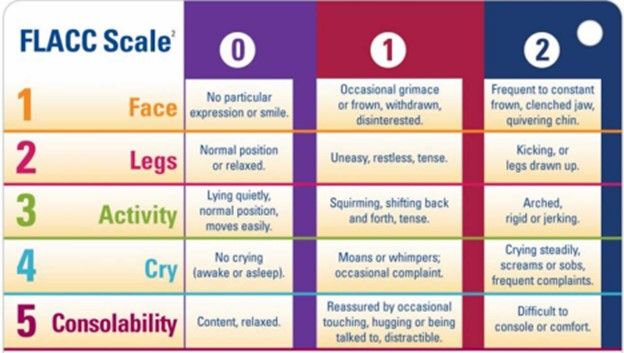A nurse is planning care for a 2-month-old infant following a surgical procedure. Which of the following pain rating scales should the nurse plan to use to determine the infant's level of pain?
PANAD scale
OUCHER scale
FLACC scale
FACE Scale
The Correct Answer is C
The appropriate pain rating scale to use for a 2-month-old infant is the FLACC (Face, Legs, Activity, Cry, Consolability) scale. The FLACC scale is commonly used for infants and young children who are unable to self-report their pain. It assesses facial expression, leg movement, activity level, cry, and ability to be consoled. Each category is scored on a scale of 0 to 2, and the total score provides an indication of the infant's pain level.
The PANAD scale and OUCHER scale are more commonly used for older children, while the FACE scale is specific to assessing pain in individuals with cognitive impairments.

Nursing Test Bank
Naxlex Comprehensive Predictor Exams
Related Questions
Correct Answer is B
Explanation
At the age of 3, children typically start to develop better balance and coordination. They may be able to stand on one foot for a short period of time, although their ability to maintain balance may vary.
Walking backward heel to toe, skipping, and hopping on one foot are typically achieved around the age of 4-5 years.
As for vocabulary, a 3-year-old child may have a vocabulary of approximately 300-500 words, although the exact number can vary. A vocabulary of 1500 words is more commonly seen in older children.
Correct Answer is C
Explanation
Hospitalization can be a challenging and unfamiliar experience for children, especially when they are separated from their family and siblings. Providing clear information about visitation policies and explaining the reasons for restrictions can help the child understand and cope better with the situation.
While orienting her parents and explaining hospital schedules can be beneficial, the focus should be on directly addressing the needs and concerns of the child to support her adjustment. Using caring and comforting language is important, but it should be combined with age-appropriate explanations and addressing specific concerns related to the child's situation.
Whether you are a student looking to ace your exams or a practicing nurse seeking to enhance your expertise , our nursing education contents will empower you with the confidence and competence to make a difference in the lives of patients and become a respected leader in the healthcare field.
Visit Naxlex, invest in your future and unlock endless possibilities with our unparalleled nursing education contents today
Report Wrong Answer on the Current Question
Do you disagree with the answer? If yes, what is your expected answer? Explain.
Kindly be descriptive with the issue you are facing.
